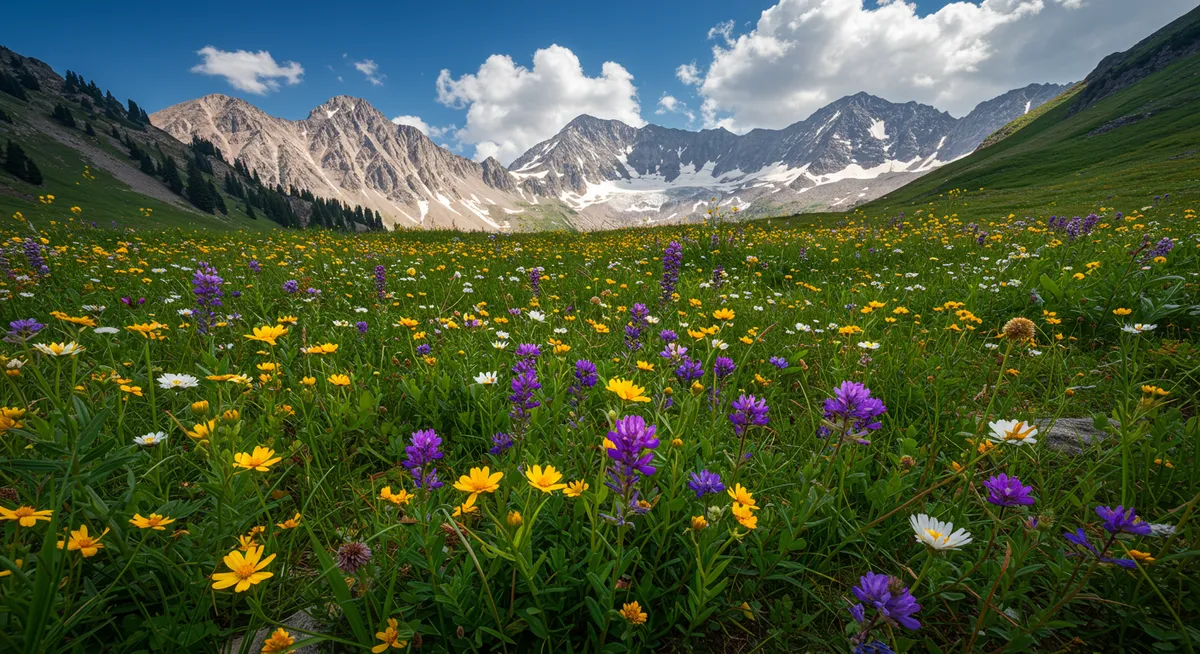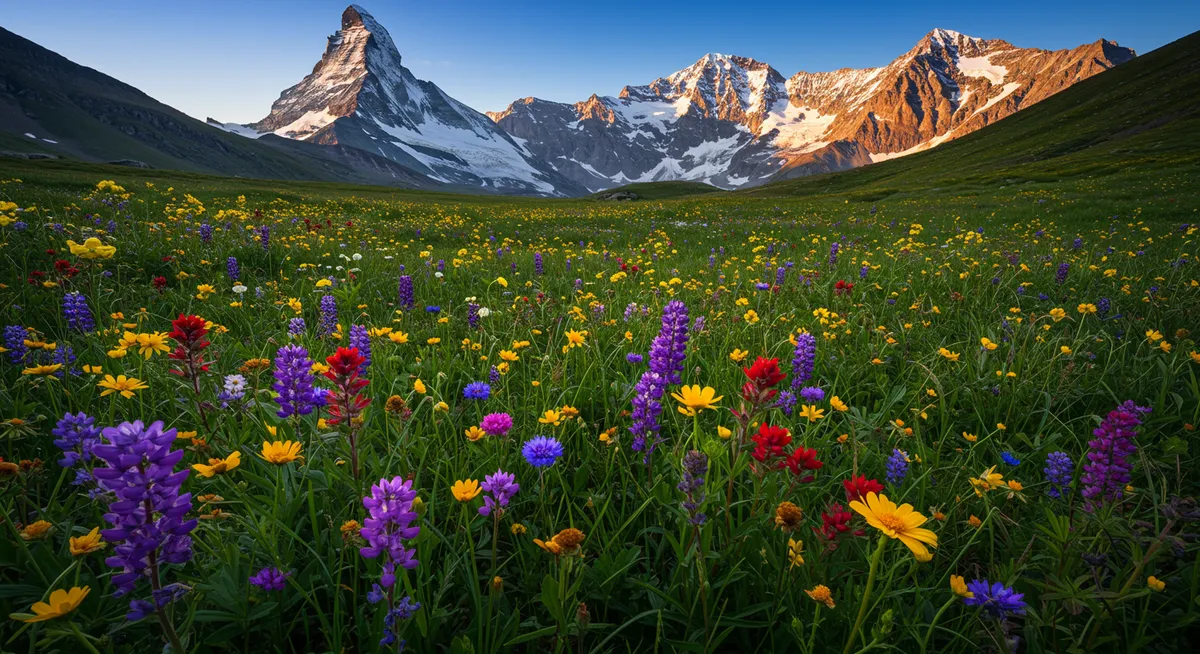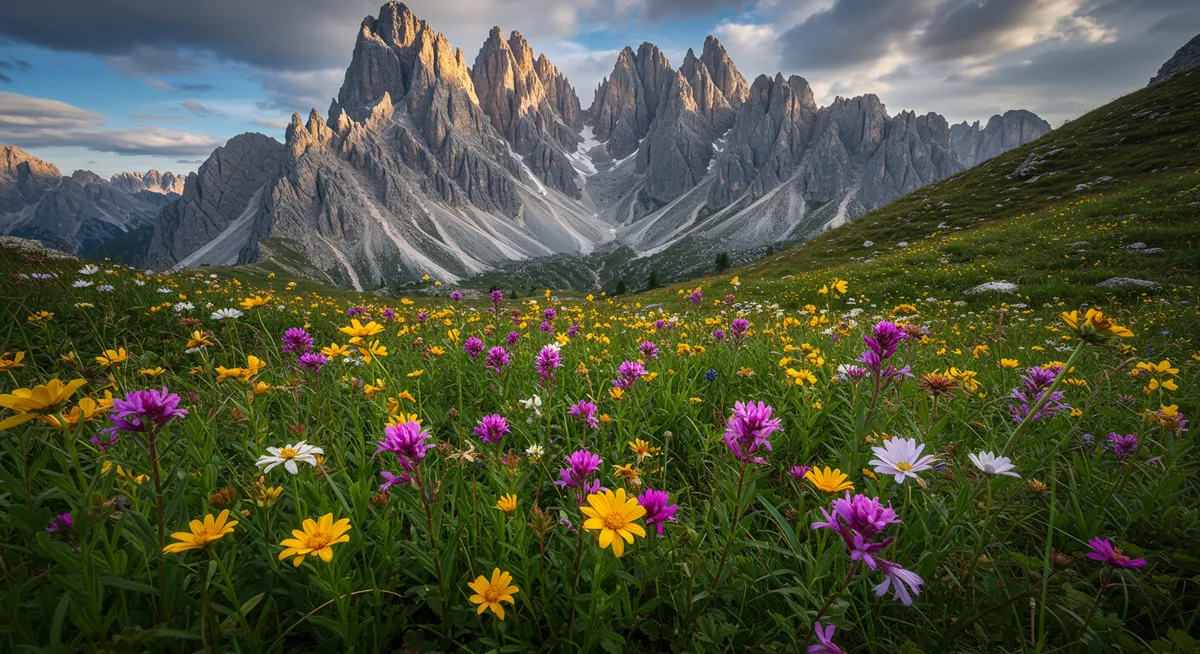Alpine Wildflower Walks in Europe's Mountains: Spring's High-Altitude Tapestry

Alpine Wildflower Walks in Europe's Mountains: Spring's High-Altitude Tapestry
As winter's grip loosens on Europe's mountainous regions, one of the continent's most spectacular natural phenomena begins. The retreating snowline reveals mountain meadows that rapidly transform into breathtaking carpets of wildflowers. Unlike the gradual progression of lowland spring, this high-altitude awakening happens with remarkable speed and intensity, creating a vibrant but fleeting spectacle that hikers and nature enthusiasts eagerly anticipate each year.

The Extraordinary Alpine Wildflower Ecosystem
Alpine wildflower meadows represent remarkable adaptations to one of Europe's most challenging environments. These specialized ecosystems have developed unique characteristics:
- Compressed Growing Season: Alpine plants must complete their entire life cycle in just 60-90 days between snowmelt and the return of harsh conditions
- Cold-Weather Adaptations: Many alpine flowers have specialized features like dense hair covering, compact growth forms, and dark pigments that absorb solar radiation
- Intense Pollinator Competition: The shortened growing season creates fierce competition for pollinators, resulting in particularly vibrant, nectar-rich blooms
- Evolutionary Isolation: Mountain ranges create isolated "islands" where unique flower species evolved independently, resulting in extraordinary diversity
- Ancient Origins: Many alpine flowers represent ancient lineages that survived in mountain refuges during ice ages, making them living botanical fossils
These factors combine to create floral displays of exceptional diversity and visual impact. A single alpine meadow may host 100+ flower species within a small area, creating complex mosaics of color unmatched in lowland environments.
The Alps: Classic Alpine Wildflower Routes
Swiss Alps Flower Trails
Switzerland offers some of Europe's most accessible and well-maintained alpine wildflower trails, with several standout routes for spring and early summer hiking:
In the Bernese Oberland region, the 6-kilometer Schynige Platte Alpine Garden Trail represents perhaps the quintessential alpine flower experience. Starting from the historic rack railway station at 1,967 meters, the trail winds through professionally maintained botanical stations showcasing over 600 alpine plant species. The route combines stunning panoramic views of the Eiger, Mönch and Jungfrau peaks with educational displays explaining the unique adaptations of alpine flora.
For a more immersive wilderness experience, the 8-kilometer Albula Pass trail in eastern Switzerland traverses remarkably diverse wildflower meadows. The limestone-rich soils support distinct plant communities including rare orchid species like the Lady's Slipper and Black Vanilla Orchid. The meadows typically reach peak bloom in mid-June, slightly later than lower-elevation sites.
In the southern canton of Ticino, the Monte Generoso ridge walk offers a different alpine flower experience with Mediterranean influences. This 5-kilometer high-altitude trail features unique flower combinations where central European alpine species mix with Mediterranean flora, creating distinctive color palettes not found elsewhere in the Alps.
French Alps Flower Meadows
The French Alps host particularly diverse wildflower displays due to varied geological conditions and climate influences from both Continental and Mediterranean weather systems.
The 7-kilometer Circuit des Alpages in Vanoise National Park offers one of France's most celebrated wildflower experiences. Starting near Pralognan-la-Vanoise, this moderate loop trail traverses alpine meadows renowned for exceptional diversity, including the iconic blue Alpine gentian, delicate Alpine snowbell, and multiple edelweiss colonies. The area's protected status since 1963 has allowed flower populations to thrive undisturbed.
Further south, the 3.5-kilometer Lac Miroir trail in the Queyras region combines high-alpine lake views with spectacularly diverse flower meadows. The area's isolation and traditional farming practices have preserved ancient meadow ecosystems where over 40 orchid species can be found alongside classic alpine flowers. The southern location means earlier blooming, with peak displays typically occurring from late May through mid-June.
In the Mercantour National Park bordering Italy, the Valley of Wonders trail offers a unique combination of prehistoric rock carvings and exceptional wildflower displays influenced by both Alpine and Mediterranean climates. The 9-kilometer route features distinctive southern alpine species rarely seen elsewhere, including various endemic campanulas and saxifrages.
The Dolomites: Italy's Wildflower Paradise
Seiser Alm (Alpe di Siusi) Meadows
The Seiser Alm in South Tyrol forms Europe's largest high-alpine meadow at 56 square kilometers, creating perhaps the continent's most extensive wildflower display. This gently rolling plateau at approximately 2,000 meters elevation offers several exceptional walking routes:
The 8-kilometer Panorama Trail traverses the meadow's heart during peak bloom (typically mid-June to early July), passing through distinct wildflower zones influenced by subtle changes in elevation, moisture, and soil composition. The route provides extraordinary photographic opportunities with the distinctive Dolomite peaks creating dramatic backdrops for flower-filled foregrounds.
For those seeking a more challenging experience, the 12-kilometer Monte Pez Circuit climbs from the meadows to higher rocky terrain, showcasing the transition from lush flower meadows to specialized high-alpine plant communities that thrive in seemingly inhospitable rocky environments.
Tre Cime di Lavaredo Wildflower Circuit
Perhaps the Dolomites' most iconic landscape, the area surrounding the three distinctive Tre Cime peaks offers exceptional wildflower viewing combined with dramatic mountain scenery. The classic 10-kilometer circuit around these towers passes through varied habitats supporting distinct flower communities.
The north-facing meadows feature moisture-loving species including globe flowers and various orchids, while the drier southern slopes host colorful cushion plants and alpine poppies. The eastern sections, receiving morning sun, support particularly diverse wildflower assemblages where endemic Dolomite species mix with more widespread alpine flowers.
What makes this route particularly special is the opportunity to observe specialized plant communities that have adapted to the unique Dolomite geology, with its distinctive pale limestone composition creating specific growing conditions found nowhere else in the Alps.

The Pyrenees: Wild Flower Frontiers
Ordesa Valley Wildflower Routes
The Spanish Pyrenees host some of Europe's most pristine alpine environments, with the Ordesa Valley in Ordesa y Monte Perdido National Park offering exceptional wildflower hiking opportunities. The valley's varied topography and geology create distinct microhabitats supporting remarkable floral diversity.
The 16-kilometer Faja de Pelay trail, while challenging, rewards hikers with spectacular flowery meadows contrasting against dramatic limestone cliffs. The route passes through distinct ecological zones where different flower communities dominate, from lush valley-bottom meadows to high-alpine rocky gardens. The area's isolation has preserved ancient plant communities that have disappeared from more developed Alpine regions.
For a less demanding experience, the 6-kilometer Cola de Caballo (Horse's Tail) waterfall route traverses the valley floor through meadows that typically reach peak bloom in mid-June. The combination of wildflowers, waterfalls, and the valley's distinctive beech forests creates uniquely varied scenery throughout the walk.
Cirque de Gavarnie Flower Walks
On the French side of the Pyrenees, the UNESCO-protected Cirque de Gavarnie offers breathtaking wildflower displays against the backdrop of its iconic natural amphitheater. The 7.5-kilometer loop trail around the cirque passes through exceptionally diverse meadows where Pyrenean endemics like the Pyrenean Lily and Ramonda (a rare "living fossil" plant) can be found alongside classic alpine flowers.
The area's unique combination of Atlantic and Mediterranean climatic influences creates distinctive flower combinations not seen in the more central or eastern mountain ranges. The meadows typically reach peak bloom slightly later than equivalent Alpine locations, making this an excellent destination for early July wildflower experiences.
Timing the Alpine Flower Season
Elevation and Bloom Progression
The timing of alpine wildflower displays follows predictable patterns based on elevation, but varies annually depending on winter snowpack and spring temperatures:
- Sub-Alpine Meadows (1,400-1,800m): Late May to mid-June
- Lower Alpine Zone (1,800-2,200m): Mid-June to early July
- Upper Alpine Zone (2,200-2,600m): Early July to late July
- Nival Zone (above 2,600m): Late July to mid-August
This elevation-based progression creates a "moving window" of peak bloom that advances upward approximately 100 meters per week during late spring and early summer. Savvy hikers can extend their wildflower season by starting at lower elevations and gradually moving higher as the season progresses.
Optimal Viewing Windows by Region
Different European mountain ranges reach peak bloom at slightly different times due to local climate patterns:
- Southern Dolomites: Early June to early July (earliest)
- French/Swiss Alps: Mid-June to mid-July
- Austrian/German Alps: Late June to late July
- Pyrenees: Late June to late July (slightly later)
Local tourism websites and alpine garden organizations increasingly offer "bloom trackers" that provide real-time updates on wildflower progression, helping visitors optimize their timing. Heavy winter snowpack generally delays the season but ultimately produces more spectacular displays due to increased moisture availability.
Photography Tips for Alpine Wildflowers
Alpine environments present unique photographic challenges and opportunities. The intense mountain light creates both problems and possibilities—harsh midday sun can wash out flower colors, while early morning and late afternoon light produces extraordinary illumination of flower-covered landscapes. Consider using polarizing filters to reduce glare and enhance the naturally vibrant colors of alpine blooms.
For landscape shots incorporating both flowers and mountain backdrops, experiment with different focal lengths to compress or expand the perceived distance between foreground meadows and background peaks. Wide-angle lenses allow you to include dramatic skies above the mountains, while longer focal lengths compress the scene to emphasize the relationship between flowers and peaks.
For close-up photography, the constantly moving mountain air presents challenges. Increase your ISO setting to allow faster shutter speeds, use a reflector to fill shadows, and consider bringing a portable windscreen to protect delicate blooms from breeze during macro photography sessions.
Conservation Considerations for Alpine Flower Walks
Threats to Alpine Meadows
Despite their remote locations, Europe's alpine wildflower ecosystems face significant challenges:
- Climate Change: Warming temperatures are pushing flower zones upward, with lower-elevation species increasingly competing with specialized alpine plants
- Abandonment of Traditional Grazing: Many flower-rich meadows evolved alongside centuries of carefully managed grazing that prevented forest encroachment
- Tourism Development: Expansion of ski infrastructure and mountain tourism facilities can damage fragile habitats
- Overcollection: Despite legal protections, rare species like edelweiss still face pressure from illegal collecting
Responsible Alpine Wildflower Viewing
Support conservation of these extraordinary ecosystems by practicing responsible hiking:
- Remain strictly on established trails, as alpine vegetation can take decades to recover from trampling
- Never pick wildflowers—many are protected by law, and all play vital roles in the fragile alpine ecosystem
- Learn to identify threatened species and report unusual sightings to park authorities, contributing to citizen science efforts
- Support traditional alpine farming practices by purchasing local products from mountain communities that maintain flower-rich meadows
- Consider visiting less-famous wildflower areas to reduce pressure on heavily traveled routes
Alpine Wildflower Identification
While European alpine zones host hundreds of flower species, learning to recognize key families and signature species enhances the hiking experience. Look for these iconic alpine flowers:
- Gentians: Particularly the intense blue trumpet-shaped Alpine gentian (Gentiana acaulis)
- Edelweiss: The white star-shaped symbol of the Alps (Leontopodium alpinum)
- Alpine Pasque Flower: Purple, silky-haired early bloomer
- Various Orchids: Including the black vanilla orchid and lady's slipper
- Alpenrose: Vibrant pink rhododendron covering higher slopes
- Alpine Snowbell: Delicate white bells often found at the edge of melting snow
Many alpine visitor centers offer day courses on wildflower identification at the start of the blooming season. These provide an excellent foundation for appreciating the diversity encountered on the trails. Several smartphone apps now offer alpine flower identification features that work offline in remote mountain areas.
Cultural Connections to Alpine Flowers
Alpine wildflowers hold deep cultural significance across European mountain communities. Traditional alpine herbal medicine has utilized many species for centuries, with some plants like arnica and gentian still providing active ingredients for modern pharmaceuticals.
In folk traditions, certain flowers marked important seasonal transitions or were believed to possess magical properties. The edelweiss in particular features prominently in alpine folklore, traditionally given as a token of love and dedication, as gathering it from steep rocky slopes demonstrated courage.
Many alpine communities still celebrate seasonal wildflower festivals, with events like South Tyrol's Almabtrieb (the decorated return of cattle from summer pastures) featuring wildflower garlands and crowns that honor the connection between traditional alpine farming and the meadows' floral diversity.
Beyond Summer: Alpine Autumn Flower Surprises
While spring and early summer represent peak alpine bloom periods, dedicated nature enthusiasts should consider late-season mountain visits. Many alpine regions experience a distinct secondary flowering period in late August and September, when gentians, autumn crocuses, and alpine asters create subtler but equally beautiful displays.
These autumn flowers often coincide with spectacular fall foliage on alpine shrubs and trees below the treeline, creating colorful compositions that few visitors witness. The lower-angle autumn light enhances photography, while dramatically reduced crowds provide more peaceful nature experiences.
Practical Planning for Alpine Wildflower Treks
Alpine environments demand proper preparation beyond enthusiasm for flowers. Weather conditions can change rapidly even during summer, with afternoon thunderstorms common. Dress in layers, carry rain protection, and always bring more water than you expect to need—the dry mountain air increases dehydration risk.
For optimizing wildflower experiences, consider basing yourself in mountain villages with multiple trail options at different elevations and aspects, allowing adjustments based on current bloom conditions. Many alpine regions offer week-long "flower walker's passes" that include both transportation and accommodation discounts for nature-focused visitors.
When available, joining guided wildflower walks led by local botanists or national park rangers enormously enriches the experience through specialized knowledge about the plants and their ecological and cultural contexts. These guided experiences often access special conservation areas with particularly rich or rare flower displays not accessible to independent hikers.
Explore More Spring Nature Wonders
Europe's alpine wildflowers represent just one of spring's spectacular natural displays.
Discover other breathtaking seasonal phenomena in our guide to Spring Nature Walks Around the World.